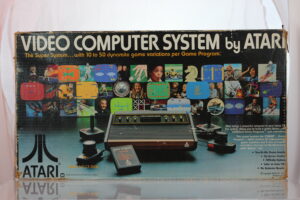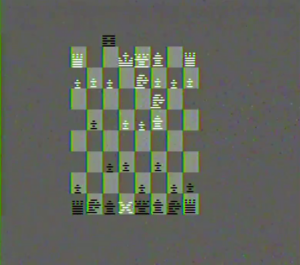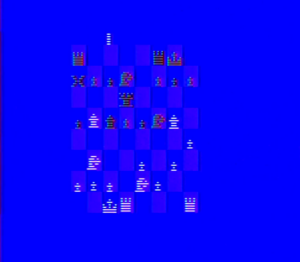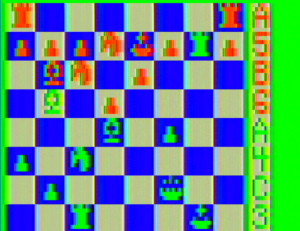
The final VCS game from the 1970s was a long time coming. Video Chess is a technical feat in several ways, and it’s also a game that owes its existence in part to a marketing decision dating back to the VCS launch back in 1977, and to the joint efforts of one of the original software developers on the platform and one of the company’s star programmers making it a reality.
Chess, for the unfamiliar, is another ancient board game like Backgammon before it. Its origins date back to the Gupta Empire, located in modern day India from roughly the mid-200s until 543. From there it spread westward with some rule changes as chess, reaching as far as Europe by the year 1000 and becoming modernized with its current ruleset around 1500. The goal of the game is to put your opponent’s king piece into a position where it cannot escape being captured by your pieces, known as checkmate. To both do this and prevent this from happening to your own king, players have a number of pieces that move in different ways: bishops move diagonally, knights move in a weird L shape, rooks move along straight lines, and the queen can move diagonally or in lines. Pawns, the most numerous piece, generally are only able to move ahead one square unless its their first move or they are capturing another piece, which can only be done one square ahead and diagonally in front of them. The king can move in any direction, but only one square at a time.

Back in 1977 when the VCS came out, the console’s box included a chess piece in the art indicating all the different kinds of games you can play. At the time, Atari didn’t have a chess game in development, and it’s unlikely that this was supposed to do more than relay that this was a game machine using well-known, public domain visual indicators. Nevertheless, as time went on Atari started fielding calls from people asking about a chess game, leading to marketing to begin asking the VCS software team about making one. Early on, according to software developer Bob Whitehead, the programmers did feel like it wouldn’t be doable to put an entire chess board on screen with all the pieces moving around.
Whitehead, not one to accept something was impossible on the VCS, realized that he could change the graphics on the fly as long as the pieces weren’t animated moving around simply by alternating the lines used to draw each piece. This is why, if you look closely, each piece alternates which lines its drawn on. This became known as the “Venetian Blinds” technique, one that would be brought up in a future lawsuit between Atari and Activision. After creating a screen mockup for marketing, they gave him the green light to move ahead on the game sometime in 1978.
Meanwhile, Atari engineer Larry Wagner, a lifelong chess player himself, was becoming more interested in the idea of microprocessors playing chess, particularly from the machine learning angle. He was even roped in as a tournament director for hobbyists to pit their computers against one another in the game at the second annual West Coast Computer Faire in 1978, won by Sargon Chess. Wagner was, if you remember, one of the engineers who worked on the VCS’s development and would go on to write the bulk of Combat after Joe Decuir started his initial Tank proof of concept prototype. After Combat Wagner was put on a “catch and kill” project with a Signetics microprocessor, and found himself interested in a variety of other, non-software avenues. The idea of getting a chess program on the 6502 processor interested him into coming back around to software, and he wanted to give it a shot, joining Bob Brown’s advanced research projects team to work on the game. After declaring he could write an algorithm to make the game run on the VCS, Wagner would collaborate together with Whitehead, with additional assistance from Julio Kaplan, a chessmaster and consultant interested in computer chess games (Kaplan also assisted in the development of Backgammon for the VCS as an enthusiast of that game as well).
Wagner primarily worked on the program algorithm for the computer opponent at home, programming in FORTRAN using a time share system. For six months, he said, he had between 5 and 8 chess boards set up to test and tweak his algorithm in different circumstances – a situation that has, incidentally, lead to him barely playing chess since. 64 bytes of the VCS’s 128 bytes of memory were dedicated to the display and position of objects on the screen, so Wagner had all of 64 bytes to work with for his game’s decision tree algorithm.

Whitehead, an expert VCS coder by this point, was able to translate Wagner’s FORTRAN algorithmic code into an assembly language, table-driven format that the VCS microprocessor could understand and also that would fit on the cart. This was then married to the display he had put together. Whitehead also worked on the algorithm himself, with help from Kaplan since he wasn’t much of a chess player, and ultimately the three of them produced a game that could look ahead a handful of moves and weigh the value of each piece and each move to determine how it would counterplay. Whitehead notes the computer is weak on its opening, but can play a pretty decent game beyond that point. The screen blanking when the computer is moving was simply a consideration of processing time and power – typically the computer is only doing its calculations during the “video blank” period when it’s not directly drawing anything on screen; it’s typically somewhere around a 90-10 split between visual data and the CPU thinking. This wasn’t going to work for a game like Chess, so Wagner and Whitehead opted to have the screen blank out to allow the CPU its full processing power to consider its next move.
Around this time, Whitehead said, Sargon Chess was published through an advertisement in Byte magazine. The gold standard chess program of its time, its release lit a fire under Whitehead and Wagner to see if they could make their little game more competitive – maybe not to the degree that it could beat Sargon, but enough to make it a stronger challenger. But doing so would require more program space than they had to work with. Video Chess already was running on a 4k cartridge – a rarity, since Brown’s research group was the only ones with permission at the time to use them – and the VCS itself can only recognize 4k of program space at a time. This could be expanded upon using additional hardware on the cartridge itself to allow for “bankswitching,” essentially allowing developers to retain part of their game program “off site” in the cartridge that can be called up when necessary. The two men tried to pitch their managers on developing a bankswitched cart to release a better Video Chess, but Atari ultimately decided not to move ahead with this bigger version of the game. The company didn’t hold out for long, however. Within a year, Whitehead said, they were developing their own bankswitched carts allowing up to 8 kilobytes of program space; by this point both Wagner and Whitehead had left the company.
That said, an older, 6k build of Video Chess does exist, having turned up on an internally produced, bankswitched combination cart along with Ed Logg’s Othello rendition (which is only 2k). The most notable differences between this and the 4k version involve the computer: unsurprisingly, it takes longer to consider its moves but plays a stronger game, according to Atariprotos.com’s Matt Reichert. It also features two more difficulty levels, in case you found the retail cart a bit weak. As for Othello, continuing to select variations beyond those 10 brings you automatically to the alternative game. Why this combination cart was created is unclear – it could possibly have been considered for a retail release, but it’s also just as likely that an Atari staffer with the know-how burned themselves a copy of the two games for personal use. Two other prototypes have turned up from seemingly the same July 1978 build: one of them found some years ago at Atari founder Nolan Bushnell’s house under the title Computer Chess. This version doesn’t have some features fully implemented but does include board coordinates, weird sound effects while the computer is thinking, and a bug that allows you to take control of a computer pawn that was fixed in the final version. Whitehead didn’t know much about the providence of Bushnell getting a copy, so why he had it remains a mystery.
Video Chess was something of a prestige release for Atari, which suggested the game be sold at a higher price tag than most of its offerings – nearly $40, the same price that the company used for Backgammon and Indy 500, which was packaged with its driving controllers. At least, they did when it finally came out; early advertisements for Video Chess indicated it was “coming soon,” but then it simply vanished from newspaper advertising until it finally debuted in November. Wagner shed some light on this in a short interview with Personal Computing’s November 1979 issue, where he said the game had suffered from technical problems and delays. In the same interview, Wagner ranks it as a Class C chess program – about the rank of an average tournament player – and notes that the higher price tag is a result of all the nearly two years of research and hard work from the developers that had to happen to make the chess game exist.

So how did Wagner and Whitehead do with Video Chess? I’m not a strong chess player, but the game does put up a good challenge for a crummy-to-average challenger. The select switch allows you to choose how strong an opponent you want between eight levels – which in turn also changes how long you have to wait for the computer to think between moves, up to 10 hours at the highest setting. Interestingly, the eighth difficulty level is actually a “beginners mode” where the computer takes only up to 10 seconds to plan its moves; this might be the first VCS game to have a specific skill level for young or new players. The left difficulty switch allows you to set the board up however you want, while the right switch determines if the player or the computer controls the white pieces, which move first. All the rules of chess are implemented in this version of the game, and the manual does a pretty good job of explaining what each piece does and how the game is played. If, like me, you’re a complete amateur, even the second difficulty level is enough to give you a hard time. Reportedly the game does feature a glitch at the level 6 and 7 difficulties where the computer will move pieces around during its thinking phase and never move them back. What I’ve read is actually happening is that pieces disappear from the board, but will reappear if the controller is moved. I didn’t sit around for 10 hours to make sure this was the case.
The press at the time suggests that Video Chess was highly regarded in its day. David Ahl wrote about it in a November Creative Computing article, and while he wasn’t a fan of the graphics, he appreciated the computer opponent’s skill, the ability to set up the game for specific situations, and the implementation of the en passant and castling rules. Bill Kunkel and Arnie Katz reviewed the game in their April 1980 Arcade Alley column in Video magazine, praising the computer opponent but lamenting there was no two-player mode.

If you owned a home game console and were a chess fan during the VCS’s heyday, you didn’t have a lot of options. Chess games are difficult to make and require some serious processing muscle to create a good one. For North American residents, you were pretty much limited to Video Chess until 1983, when Mattel published USCF Chess for their Intellivision console. The only Intellivision game to have extra 2 kilobytes of RAM built into it, the game was a team effort from Teletape Incorporated – which did the gameplay programming – and Russ Ludwick, who worked on the user interface; Dave James and Peggi Decarli did the graphics. The game took a record 19 weeks to debug and test, but ultimately was praised at its release. There is very little indication as to how well it sold as the extant memo tracking Intellivision sales to retailers and distributors only runs through June 1983 and this game does not appear on it despite releasing in March that year, though since the Intellivision market had more or less collapsed in 1983 against intense pressure from Coleco’s “next gen” system and the broader market crash it’s likely this did not do as well for the company as marketing had hoped. Years later USCF Chess would join Mattel’s APBA Backgammon and Checkers in a combo cart, Triple Challenge, released in 1987 by INTV; due to USCF Chess‘s additional memory requirements, this cartridge really only happened because INTV was able to buy a stockpile of defective 4-kilobyte memory chips that nonetheless still had 2k of contiguous RAM to work with.
Bally had announced a chess game for the Professional Arcade console at the January 1980 CES show, but it never came out; a basic two-player Chessette game was written for the BASIC cart, but never anything with a computer opponent. And honestly, at that point it would just be easier to get out a chessboard, but I’ll grant there is something delightfully novel about playing out your match on the TV.

Europeans had a few more options for their chess fix though. The West German Channel F variant, the Saba Videoplay, received its own chess game titled Schach, and though it’s unclear when exactly it came out it seems to have been available while Fairchild was still selling the Channel F into 1979. According to Fairchild engineer and head of the Channel F team, Jerry Lawson, during his talk at Classic Gaming Expo 2004, Saba was struggling to sell the system and requested a chess game be made, as that was something they knew would sell in their country. Lawson said the game was functionally packed in with the console and it was sold as chess-playing game system; this way people who already owned it would be interested in checking out the other games Saba had on offer. Known as Superchess on internal Fairchild documents currently held at the Strong Museum of Play, this game featured a red light on the cartridge that would indicate when the computer is thinking about its next move; a handy feature that Lawson said let you know your console hasn’t frozen up. It does play a pretty good game of chess, though I haven’t found anything to suggest how well Saba’s ploy played out. They didn’t seem to be the only company who had the same idea, however: the European Odyssey2, the Videopac G7000, received a whole chess module called the C7010 with its own microprocessor to run the game sometime around mid-1982. An interesting aspect of this particular version is that the game provides some insight into what moves its considering on its turn – there’s a running tally of what its currently considering alongside another coordinate value of the best move it’s found so far in its planning. Much like USCF Chess, Videopac Chess also includes a “tournament mode” that gives each side a hard limit on how much time they can use to consider their moves.
With this, we close the book on Atari’s 1979. The home gaming landscape has shifted over the course of these 12 months. By the end of the year, Fairchild, previously the strongest competitor to Atari in the home console space, had essentially been rendered defunct by the meltdown of the digital watch market, and had sold the rights to its video game division to Zircon in the process. Zircon would work on clearing out old stock of systems and cartridges before selling the Channel F’s final batches of new games over the next couple years. APF had refocused its efforts on the Imagination Machine, a full computer expansion of the MP1000 that was critically praised but sold poorly. Bally still struggled with its Professional Arcade production issues through the year, but continued to promise a full computer expansion for the platform; meanwhile its fanbase started to develop and distribute its own BASIC games while reverse engineering the hardware to produce their own add-ons – the first major one, the Blue RAM expansion, would be sold in 1980. The “next generation” Intellivision test launched in November in Philadelphia, Baltimore and Washington DC stores courtesy of Sylvania and in the Bay Area directly from Mattel; the console would slowly roll out across the US until going national in mid-1980 and eventually sit in a distant second place to the VCS in the North American market. And Magnavox is still chugging along, albeit reluctantly, with its Odyssey2 platform, supported and championed largely by Ed Averett. Averett had convinced the company to keep the platform alive by designing a prodigious number of games as a contractor, with his wife Linda Averett doing the heavy lifting of programming many of them. Sales of the console were stronger than its detractors in Magnavox anticipated, and while they didn’t rival what Atari was doing in 1979, they were strong enough to keep it alive. Atari itself sold an estimated 600,000 VCS units over the year, bringing the install base to over 1 million machines and clearing out its leftover stock from 1978’s production run.
At Atari itself, the company’s star consumer software developers left the company over the summer, annoyed with a lack of credit and poor compensation. Later that year they’d go on to found Activision, the first third-party console game company, and their success would lead to a continued brain drain in the coming years as Atari’s developers leave to form their own companies. Atari would hire new game devs, and folks like Rob Fulop, Rick Maurer, Carla Meninsky and Carol Shaw would go on to make huge hits for Atari and in some cases, elsewhere, but a precedent has been set: developers could leave Atari and ply their skills elsewhere. Atari did successfully launch its 8-bit computers at the very end of 1979, though struggles with getting FCC approval drove up production costs and with it, price tags. And in the vitally important arcade space, the company released Asteroids, one of the biggest arcade hits of all time and one we’ll get to when we reach its VCS conversion; at the same time Namco and Midway published Galaxian, popularizing color graphics in arcade games and leading them to become a new standard Atari would take advantage one in the coming years. The company also shut down its pinball division in 1979, ending with the release of the oversized machine Hercules, but the success of its video games ensured that Atari had the resources to be the most dominant company in the arcade gaming space into the next year. And indeed, that next year is about to see Atari extend that market dominance into the home gaming space in North America, with a rise no one truly could have anticipated in 1979. And while this rise is predominantly due to the impending Space Invaders, games like Superman and Video Chess proved in their own ways that the VCS is a more capable machine than any of its designers could have possibly expected – one that can pull off a wild array of games and genres over the decade to come, and beyond. It was truly a strong note to end the year on.
Sources:
Larry Wagner, interview with the author, August 25 2018
Bob Whitehead, interview with the author, September 4 2018
The Jerry Lawson Papers, Strong Museum of Play
The Fairchild Channel F Panel, Classic Gaming Expo 2004
USCF Chess, Blueskyrangers.com
Creative Computing, November 1979
Arcade Alley, Video, April 1980
Personal Computing, May 1978 and November 1979
Video Chess, Atariprotos.com
Arcadian, Dec. 22, 1979, March 24, 1980
First Steps in Computer Chess Programming, Byte, October 1978
G7000 Video Game Club News, issue 7, year unknown
Kilobaud, June 1978
Philips: L’echec est un Succes, Tilt, May 1983
Annual round up:
Merchandising, Feb 1979, March 1979, July 1979, August 1979, October 1979, December 1979, June 1980
Weekly Television Digest, April 2, 1979, Nov. 12, 1979, Nov. 19, 1979, Nov. 26, 1979
Atari Coin Connection, January 1979
Game release date sources:
Video Chess (Atari VCS): Personal Computing, November 1979; Creative Computing, November 1979; Kittanning Leader-Times, November 20 1979; Lowell Sun, December 1 1979; The Herald News, November 21 1979
USCF Chess (Intellivision): Computer Entertainer, March 1983; Computer Entertainer, April 1983; Los Angeles Times, March 5 1983; Herald News, March 20 1983;Blue Sky Rangers game list
Chessette (Bally BASIC): Arcadian, March 24, 1980
Schach (Saba Videoplay): Unknown, likely around 1978 based on Lawson’s CGE 2004 talk.
Videopac Chess (Philips): Likely 1982, based on Tilt and G7000 Game Club News dates.
